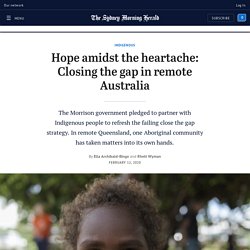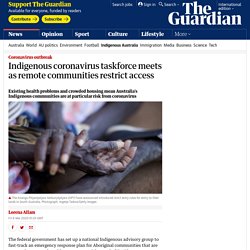

Australia's health 2020. Australia’s health 2020 is AIHW’s 17th biennial flagship report on health.

It explores topical health issues and brings together multiple data sources to serve as a report card on the health of Australians. The report considers health to be much more than the presence or absence of disease—health reflects the complex interactions of a person’s genetics, lifestyle and environment, and is fundamental to an individual’s wellbeing. Meet the Aboriginal doctor turning tragedy to triumph. Dr Vinka Barunga has lived through the statistics that reflect the struggles of her people, but has never let them define her potential.

“I can't really remember a time that I didn't want to be a doctor,” Vinka Barunga says. As a Worrorra woman from Derby, in the Kimberly region of Western Australia, Vinka grew up in the Aboriginal community of Mowanjum. “The end goal [with medicine] is to go home to the Kimberley and to work in the community I came from,” she explains. Australian Institute of Health and Welfare data shows of the 88,000 medical practitioners employed across the country in 2015, just 0.5 per cent were Indigenous – or about 400 people. For Vinka, her teenage years came with an increased awareness of how European settlement ruptured the lives of her community, and in turn, created enduring health challenges. Vinka’s dad was born on Kunmunya mission, after the Worrorra people were moved off their traditional lands along the northern coastline of Western Australia.
(1) The Best Digital Advertising Trends of 2018. (1) headspace - Australia's National Youth Mental Health Foundation. (1) Aussie teens face physical and mental illness. Mental health concerns increasingly common among young Australians, report finds - Health - ABC News. Almost a quarter of young Australians are facing mental health challenges, with young women twice as likely as young men to be grappling with psychological issues.

Key points: youth mental health Key points In 2018, 24.2 per cent of young people experienced mental distress, up from 18.7 per cent in 2012Mental health concerns found to disproportionately affect young women and young Indigenous peopleMental health experts unclear why rates are getting worse, call for further action The latest youth mental health report from Mission Australia and the Black Dog Institute has found rates of psychological distress among young people have risen 5.5 per cent in the past seven years. These findings are consistent with other recent reports, and paint a concerning picture of worsening mental health in young people. The question now at the forefront of researchers' minds is: why? In 2018, 30 per cent of young women aged 15-19 experienced psychological distress. Coping with stress and school problems.
Closing the Gap: Aboriginal community of Lockhart River takes matters into its own hands. Leah Warradoo wants only the best for her one-year-old daughter.

The young mum sits under the shade of a fig tree at the Lockhart River family centre, letting the tropical heat wash over her as she watches her daughter Angejazayna - Ange for short - bounce around the playground with an infectious smile and relentless energy. Leah, 20, grew up in Lockhart River, a remote Aboriginal community on the eastern side of Cape York nearly 800 kilometres north-west of Cairns that’s home to around 700 people. Like most local kids, she moved south to attend boarding school in year 8 - in Leah’s case, almost 2500 kilometres south to Downlands College in Toowoomba. She finished high school and had planned to study at TAFE, when she made an impulsive decision to return to Lockhart River. Now, with a young child and a multitude of family obligations, further study seems out of reach. “I missed that opportunity … I regret everything now,” she said.
To visitors, the sense of isolation can be unsettling. (1) Bondi Lifeguards Resuscitate Korean Tourist Ryan Kim (Dead for 5 minutes!) (1) Slings - Elevated Arm. (1) Slings - Collar and Cuff. (1) First Aid Tutorial: How to correctly sling an arm. (1) Free Online CPR Training Course - www.trainingaidaustralia.com.au. Campaigns - NSW Centre for Road Safety. To engage the community and help change unsafe behaviour on the roads, we develop education and awareness campaigns.

Towards Zero highlights the human element of the road toll and encourages all road users to change the way we think about road safety. Saving Lives on Country Roads encourages country drivers to challenge the everyday excuses used to justify unsafe behaviour on the road. More than 70 per cent of fatal crashes on country roads involve country residents. Our Stop it... Or cop it campaign warns drivers, riders and all road users breaking the road rules that they can be caught anywhere and at any time. Ride to Live gets to the heart of what keeps motorcyclists safe: making good decisions. Don't trust your tired self focuses on drivers before they get behind the wheel, helping to reduce the number of fatigue-related crashes. Indigenous coronavirus taskforce meets as remote communities restrict access. The federal government has set up a national Indigenous advisory group to fast-track an emergency response plan for Aboriginal communities that are among the most vulnerable to any potential spread of Covid-19.

The taskforce met on Thursday as remote Aboriginal communities in South Australia began to strictly limit visitors for the next three months, worried that if Covid-19 arrives it will be “devastating” for their elders and people with existing health problems. The Anangu Pitjantjatjara Yankunytjatjara (APY) have introduced strict rules for entry to their lands, which they can to do under the APY Land Rights Act. “We are protecting our people, especially those who hold our ancient cultural knowledge, and we know they are already vulnerable as they are quite old,” APY general manager Richard King said. “A lot of our people present with comorbidities like diabetes and renal failure. We have high smoking rates, overcrowding in housing, overall poor hygiene. (1) AIDS HowMany. (1) Grim Reaper [1987]
Closing the gap: Australia is failing on Indigenous disadvantage goals. Indigenous Australians don't live as long as other Australians.

Their children are more likely to die as infants. And their health, education and employment outcomes are worse than non-Indigenous people. Australia has promised to close this gap on health, education and employment. But a new report card finds we are failing on six out of seven key measures. Target: To halve the gap in mortality rates for Indigenous children under five within a decade (by 2018).Progress: There has been no significant decline in child mortality rates since 2008, and child mortality rates actually increased slightly from 2014 to 2015.In 2015, there were 124 Indigenous child deaths. Target: Halve the gap in employment by 2018.Progress: The Indigenous employment rate has fallen since 2008, as has the non-Indigenous employment rate. Credits: Reporting by Dan Conifer and Tim Leslie; illustrations by Lucy Fahey. ABC Life - Do you use sunscreen?: 1977 v 2020. (1) Speeding. No one thinks big of you.
Information and tips for parents about the HPV vaccine.